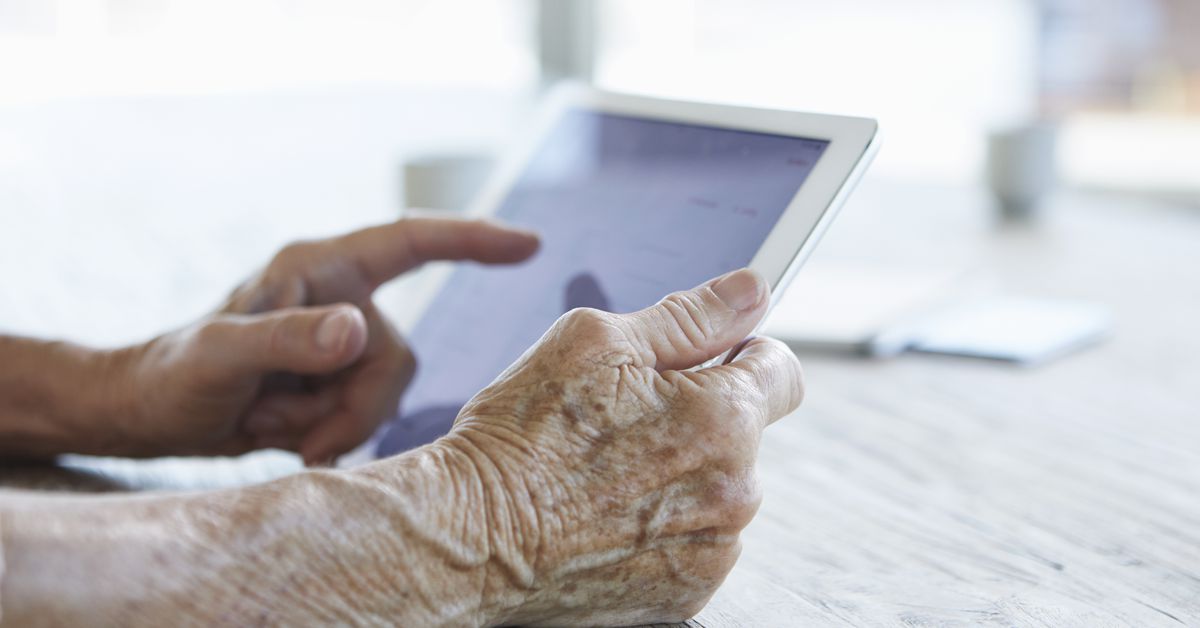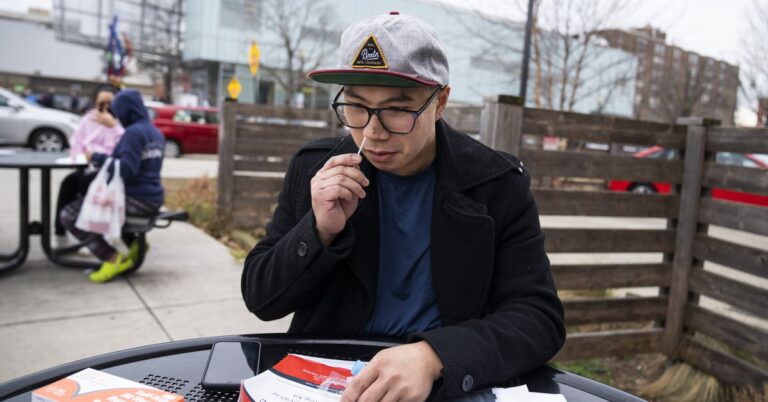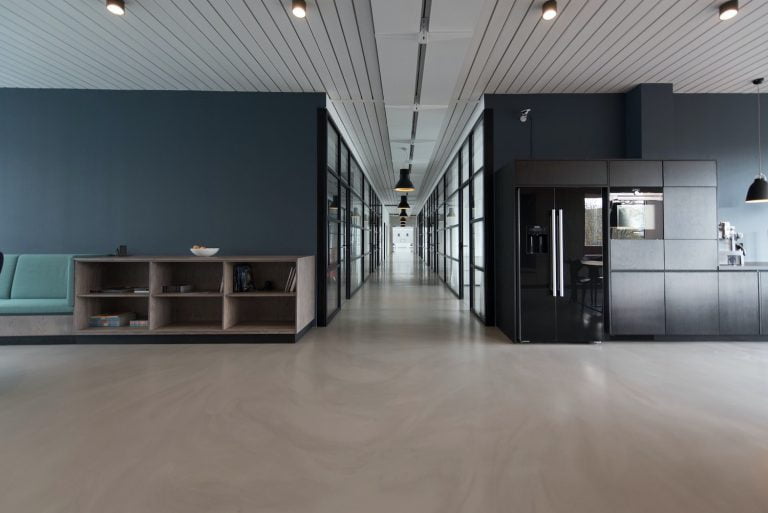
In the grim pits of 2020, ElliQ recited a poem to 81-year-old Deanna Dezern. Dezern doesn’t remember what the poem was called or who wrote it, but she says that thematically, it was about persistence and determination — qualities that resonate during a world-altering pandemic. Dezern needed reassurance; she’d spent the last year cocooned alone in her Florida home, and as the weeks turned into months, she fell into a foggy depression. Thankfully, robots cannot transmit Covid-19, which made ElliQ a perfect ally to ride out the storm.
“The poem said, ‘You can do it, just keep trying,’” Dezern continued. “ElliQ was always where I left her. She said soothing things to me. She was always ready to talk to me when nobody was around. I don’t know how to describe it. She was there for me in the way that I needed her.”
ElliQ, as you can probably infer by now, is an AI companion designed for seniors by the Israeli tech company Intuition Robotics. Think of it as an Alexa for older folks: ElliQ looks a bit like the mid-century lamp from the Pixar movies, and she can read the news, stream music, and share weather reports, all from her perch on a coffee table or kitchen counter.
But the core appeal, and the way Intuition hopes to position itself as a major player in the burgeoning elderly-oriented tech sector, is ElliQ’s empathy. It is impossible to teach a robot how to love, but ElliQ can encourage people to take their meds, to practice mindful meditation, or, in Dezern’s case, to simply be present and absorb the quiet, empty nights of retirement. That’s the guiding philosophy at Intuition Robotics; ElliQ possesses a gentle, caregiving patience that neither Apple, Google, nor any other power broker in Silicon Valley prioritizes in its products for the general public.
“ElliQ doesn’t say, ‘Would you like to listen to music?’ She says, ‘Would you like to listen to music together?’ ‘Do you want to play a game together?’ You establish trust. We want to move from doing things for someone to doing things together,” Dor Skuler, CEO and co-founder of Intuition, said in a Zoom call with Vox. “What’s unique about the senior population is that we think they’ll be early adopters of this technology. … Humans are social beings, and unfortunately, many elders are deprived of that in our society. In a weird way, they might embrace this new kind of relationship.”
Intuition Robotics isn’t the only company trying to tap into the geriatric market. Assistive tech might be a social good, but it isn’t a public good, and there’s a reason capital firms are trying to get in on the ground floor. “They’ve waited for the aging of the baby boomers, the oldest of whom are now 76,” said Laurie Orlov, a digital-industry analyst who runs the website Aging and Health Technology Watch. “And baby boomers have all the money. The tech industry understands that money talks. It’s time to pay attention.”
The executives I spoke to did not shy away from Orlov’s conclusions. In fact, Skuler believes that more entrepreneurs should investigate the potential upside of a successful slate of senior tech. “This sector is underinvested in a significant way,” he said, “considering the available spending within this population.”
One of the first personal tech devices marketed toward seniors was the Jitterbug phone. It arrived in 2005, right as smartphone mania started to sweep the country, bearing a simple, tactile layout. The blueprint made sense. For those confused by the rising touchscreen tide, and for grandparents who just wanted to call their family and never concern themselves with the app store, here was a flip phone completely divorced from all 21st-century design trends.
The Jitterbug was intentionally spartan — equipped with a dial, a clock, and a speaker button, and nothing more. And yet its popularity revealed one of the more anxious truths of the digital revolution. Between the Cloud, the algorithms, and the litany of icons splayed across our home screens, the rules of living had changed so much in the previous decade. Suddenly, technology as familiar as the telephone became extraordinarily complicated, and we worried whether America’s golden-agers could ever catch up.
One of the people trying to solve that problem is Scott Lien, a former Intuit executive who became an advocate for elder accessibility in 2014 after feeling increasingly “digitally disconnected” from his octogenarian mother in Iowa. “We tried to do video calls over Skype, and that just frustrated her,” he said. “I thought, ‘What if we designed something from scratch based on the unique needs of the typical 80-year-old?’” Shortly afterward, Lien broke ground on his GrandPad line of software, which aims to deliver a simple tablet without any complexities getting in the way.
The GrandPad comes preloaded with bingo, solitaire, and sudoku. There’s a jukebox that plays a slew of past hits (available genres include big band, classical, and ’40s,) as well as photo albums, address books, and video call functionality. All of this is presented onscreen with supersized text and large, primary-color buttons. Lien told me he and the GrandPad team actively collaborate with senior consultants to further refine the tablet’s architecture. To build a device for older folks, he said, one must be in active communication with those who know what it’s like to age.
“We had a woman named Anna helping us who was 114 years old. You learn some really interesting things from them. Anna told us about the dry skin issue. Once you hit your 90s, your skin gets really dry, papery, and leathery. Us younger guys have moisture in our skin, and that’s what makes touchscreens work,” Lien explained. “We changed the screen properties, and we include a stylus in all the packages.”
Of course, the average elderly technology user isn’t 114, and Orlov, the digital-industry analyst, believes the hackneyed image you or I might have of the typical senior — an old man befuddled and annoyed, trying to fire up a Zoom call — is out of date. The AARP reported in 2020 that more than 51 percent of people over the age of 50 purchased some sort of tech product, be it an iPad, a laptop, or a wifi-enabled television, within the previous year. In fact, AARP’s research also found that 62 percent of Americans over the age of 70 own and use a smartphone.
Those findings draw a strong contrast to a project like GrandPad, which is saddled with an interface that’s significantly scaled back compared to the Apple estate. Obviously, GrandPad and ElliQ are targeting a customer who’s considerably older and more alienated from cyberspace than the typical prime boomer, but it does make you wonder whether we’re underestimating just how commonplace tech literacy has become in our culture.
“I think technology that has been simplified to the point where you can’t really access anything is a dwindling market,” said Orlov.
Lien pushes back on that front. He believes studies, such as AARP’s, are skewed by selection bias. “It doesn’t work for this age group. They randomly call 1,000 people, and the people who are in a nursing home and don’t have a phone obviously can’t pick up,” he said. GrandPad published its own research two years ago. The company, which traveled directly to the homes of 60 people over the age of 75, found that only 8 percent of them knew how to fire up a video call. It gets to Lien’s overarching thesis: An elder might own a smartphone, but they might not know how to use it effectively. This is particularly relevant given the conditions of 2020 and the massive proliferation of fraud the year brought with it. TechCrunch reported an 18 percent increase in spam calls during the pandemic, many of which disproportionately targeted the geriatric population.
“It was catastrophic during Covid. With my mother and mother-in-law, when she got a suspicious phone call, she’d wait for me to come around so I could say, ‘Yeah Mom, that’s a scam.’ But in lockdown, when they couldn’t have their families around them, it only got worse,” Lien said. “At GrandPad, we have what’s called a circle of trust. Only the family or caregivers are invited to it, and only they can call, video call, or share photos with grandma.”
Tom Kamber, founder and executive director of the advocacy organization Older Adults Technology Services and Senior Planet, notes that he too has noticed an uptick in scams targeting older adults, particularly among the Spanish-speaking population. He believes the power brokers in technology often regard the elderly as another vague checkpoint in a superficial pursuit of diversity. To truly protect the vulnerable, he argues, the retiree population ought to be considered at every step in the value chain.
“People talk about inclusive design, and so often that means that when they’re done making something they test it with some older folks, and they say they’re being inclusive. It doesn’t work that way,” Kamber said. “The whole process of ideation and design and marketing and distribution, all of those pieces are crucial to having older adults using the technology well. If you engage with them throughout the whole process, you’re going to get a product that’s more usable, which makes people less vulnerable.”
Both of these perspectives are sound. I think we all wish we could fend off the bad actors who want to do harm to our loved ones, especially older relatives who come to the digital world as total novices. And yet I came away from this story wondering if people in my generation, all of us highly concerned 30-somethings, have been too eager to infantilize our elders. The internet is overwhelming and rife with danger, but we’ve all been forced to parse it one way or another. A preventative approach — this desire to keep our mothers and fathers insulated in an uncanny parallel dimension, filled with quasi-iPads, quasi-iPhones, and quasi-Alexas to shield them from reality — seems to miss the point. As Kamber said, surely we can inherit an internet that is safe and empowering for all users, if only we spend a little more time to consider the vast swath of humanity that is using modern technology.
Riley Gibson, president of Silvernest, feels the same way. Silvernest is a roommate-matching service designed for people around retirement age. The company’s specialty is seniors in the middle of a huge life change — a divorce, a widowing, a cross-country move — who don’t want to enter the next chapter alone in an empty house. Every Silicon Valley startup intends for its customers to wield technology and better their lives, but rarely has that same wondrous possibility been presented to the nation’s elders. Gibson says Silvernest has found the lion’s share of its clients through Facebook ads, because whether we like it or not, older folks are very much online in the same way we are. Entrepreneurs ought to consider that truth more often, Gibson argues. Maybe we should be optimistic as we watch Grandma and Grandpa organize their home screens.
“[Some companies] are designing for someone [who] needs their help. This mindset that we need to save our seniors from technology,” Gibson said. “Let’s take a broader look at how people above the age of 65 use technology. Let’s design for a hero’s journey. None of us want to feel designed down to. We need to realize that people might have more interests, or more ambition, for technology to enable them rather than fix them.”





